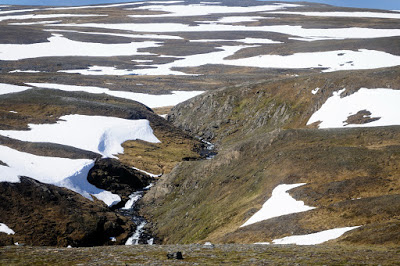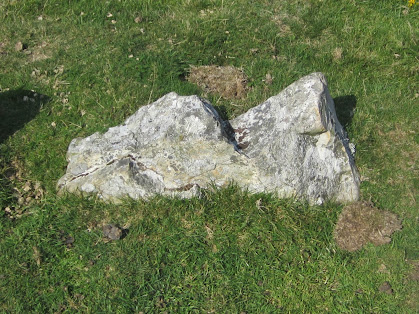In the past, I have posted a number of serious criticisms about the working methods of Parker Pearson and his team at Waun Mawn -- flagged up, as we all know, as the site of a great stone circle which was built of sacred stones from the two "bluestone quarries" at Rhosyfelin and Carn Goedog, which was then (after a few centuries) dismantled and carted off to Stonehenge.
This narrative has been carefully manufactured and promoted, and will no doubt be developed and further justified in future publications -- but the lack of scientific integrity in the whole process is now so worrying that it reflects badly on the archaeological establishment, which -- by all accounts -- simply stands back and cheers the perpetrators on.
https://brian-mountainman.blogspot.com/2018/05/waun-mawn-and-invisible-dolerites.html
https://brian-mountainman.blogspot.com/2019/07/waun-mawn-strange-art-of-seeing.html
https://brian-mountainman.blogspot.com/2018/11/waun-mawn-clutching-at-straws.html
https://brian-mountainman.blogspot.com/2019/06/waun-mawn-and-stonehenge-fantasy.html
https://brian-mountainman.blogspot.com/2018/09/waun-mawn-what-we-know.html
In a post more than a year ago I said:
I have been reviewing the Waun Mawn evidence, and have been struck again by the apparent determination of MPP and his team to see things that aren't there and to miss the things that are. For a start, they seem determined to ignore the fact that there are outcropping dolerites just a stone's throw from their putative proto-Stonehenge circle of standing stones. They so badly WANT the stones to have come from somewhere else (namely bluestone quarries) that they apparently refuse even to consider the idea that any stones erected on this site may well just have been picked up locally.
Then we have all the other rather interesting features on Waun Mawn -- all the other standing stones,
stone sockets, possible ruined burial sites, ring cairns, deer park enclosure traces, quarrying pits, embankments and so forth. Not all of them are prehistoric and relevant for the proto-Stonehenge debate, but some of them certainly are.
Why is it that thus far the archaeologists appear not even to have noticed any of these features? Strange, given that they point to a rather interesting cultural complex around Tafarn y Bwlch, Waun Mawn and Banc Llwydlos. Does it not suit their purpose to emphasise all these other traces of Neolithic / Bronze Age settlement?
Or are the archaeologists so intent on proving the uniqueness of the supposed Waun Mawn circle that all other features in the vicinity have to be ignored?
I support these points with references to a number of more detailed posts in which field observations are presented. Anyway, I have now been back again, walking the terrain and making notes, and can add further points as a result:
1. There are outcropping Fishguard Volcanics rhyolites around Bedd yr Afanc, just a couple of kilometres to the east of Waun Mawn, and also extensively to the NE, N and NW of Waun Mawn. Given the scatter of glacial deposits across the moorland and the known direction of ice travel from the N and NW, it is much more likely that any rhyolites found at Waun Mawn have been carried into the area by overriding ice. It follows that any link between Waun Mawn and Rhosyfelin (4 kn to the NE) is vanishingly unlikely.
2. The presence of spotted dolerite erratic boulders around Glanyrafon, while to some degree puzzling, indicates that we really know very little about the distribution of spotted dolerites across the landscape by glacial and other processes. It is apparent that there are other spotted dolerite outcrops in this landscape that have not yet been identified. Therefore any assumption that spotted dolerite fragments of boulders at Waun Mawn must have come from Carn Goedog or any other known location on the Preseli ridge has be be premature if not downright unreliable.
3. New examinations across the landscape of western Preseli confirms that the litter of dolerite and rhyolite boulders across the landscape is very extensive indeed -- sometimes related to the presence of rock outcrops, sometimes to periglacial blockfields, and sometimes to morainic accumulations. As I have said before, there are thousands of slabs, pillars and boulders on the hillsides and in the depressions -- and these were abundantly available for the local inhabitants who were doing things with stone in the Neolithic and the Bronze Age.
Dolerite stone setting on Waun Mawn -- this might be a collapsed cromlech, like another found on Brynberian Moor.
4. The abundance of prehistoric features across this landscape is spectacular, and every time I walk across it I quite literally stumble across stone settings that are undocumented. I am not saying that this terrain (including Tafarn y Bwlch and Banc Llywylos) was a sort of El Dorado or cultural hub -- but certainly, because of lucky chance, this area has been spared from the damage associated with land clearance and "agricultural improvement".
So I come back to my earlier points. Why is it that Parker Pearson and his colleagues (including geologists Ixer and Bevins) have completely ignored the geological map and field observations to maintain the pretence that any spotted dolerites or rhyolites at Waun Mawn (in the "stone setting" or in the debitage) have been carried here from Rhosyfelin, Carn Goedog or Cerrigmarchogion? This is, not to put too fine a point on it, deliberate falsification of the evidence designed to underpin a ruling hypothesis.
Why is it that they fail to record the presence of abundant dolerite and rhyolite "monoliths" of all shapes and sizes littered across the landscape? Again, because this is an inconvenient fact that does not do anything to help the hypothesis. Those involved appear happier when misleading their readers than when telling the truth.
Why is it that they even ignore the archaeological context in their mentions of Waun Mawn? This is extraordinary, given that these people are archaeologists, writing for an archaeological readership. Are their readers all stupid? The truth is that the Waun Mawn stone settings (whatever their wider significance may be) are simply a part of a landscape quite rich in prehistoric remains of many kinds. One can only conclude that it is the intention of the MPP research team members to maintain a pretence that the Waun Mawn "mega circle" -- if it ever existed -- was an aberration, something quite unique and special enough to have been uprooted and carried off to Stonehenge in a spectacular act of reverence or political solidarity........ and as we know, everything associated with Stonehenge has to be amazing enough to elicit purple prose and attract banner headlines.
This brings me to my final point -- the lack of control studies. The diggers at Waun Mawn have wandered across this landscape (we know that they have looked at Bedd yr Afanc) and they must know all about the Dyfed Archaeology reports on Banc Llwydlos and other concentrations of prehistoric features, but if they want to demonstrate the uniqueness of Waun Mawn, Rhosyfelin or Carn Goedog, they have to do it through comparative studies of other sites. There are organic remains in the sediments at all three sites, suggesting long occupation. At the former sites these remains and dates are used by MPP and his colleagues as confirmations of quarrying activities, and at Waun Mawn as confirmation of the presence of a great stone circle. But the "occupation traces" do nothing of the sort -- they simply show that there were human beings who used these sites. That comes as no surprise -- we already knew that prehistoric people used the whole of the landscape and exploited its resources. Until the "quarrymen" can show that the density and types of occupation traces are unique to the sites investigated, their research has no value. But they have done no control studies around other rock outcrops in the Brynberian valley which can be used in the interpretation of Rhosyfelin; they have done no control studies for Carn Goedog at any other dolerite tors on Mynydd Preseli; and they do not even accept the presence of any other prehistoric sites on Waun Mawn which might have similar or even more abundant) traces of Neolithic occupation than the putative stone circle.
So skewed is this research that it deserves to be ridiculed rather than revered. The people responsible for it are not naive -- the manner in which the "proto-Stonehenge" mega-circle is being promoted has all the hallmarks of another scientific hoax.
-----------------------------------
https://www.bluestonebrewing.co.uk/wp-content/uploads/2019/05/Waun-Mawn-2018-interim-report-lite.pdfWaun Mawn stone circle: the Welsh origins of Stonehenge (2019)
Interim report of the 2018 season
By Mike Parker Pearson, Josh Pollard, Colin Richards, Kate Welham, Dave Shaw, Ellen Simmons and Adam Stanford
Bluestone Brewery, Newport.














































